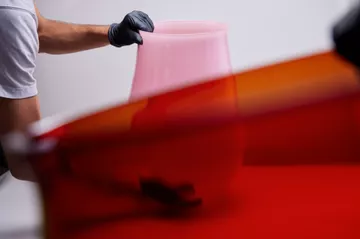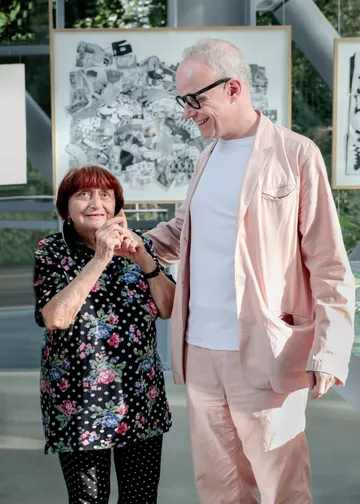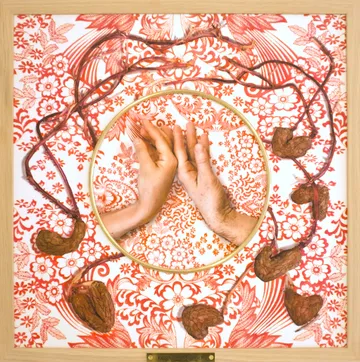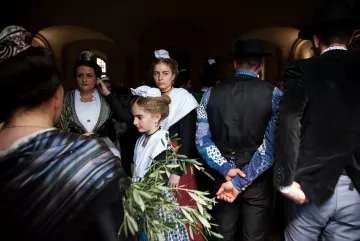
2023 Exhibition Program
Book your ticket below to visit all the exhibitions.
From May 26
Diane Arbus
Constellation
Up until the Impressionists, painting was – and still is, to a certain extent – an activity in which we fold the world and our imagination onto the still plane of the canvas.
Only the hand navigates its surface. When the painters of light left their studios to roam the cities and scour the countryside, they unknowingly invented what nascent cinema and photography would come to be. With the miniaturization of cameras in the 1920s, photography borrowed from the Impressionists this penchant for elsewhere, for the outdoors.
The photography of Diane Arbus is the result of this tireless search, the sum of countless hours of walking, dictated as much by the element of chance as by the indescribable intuition of instinct. As much as the result of her work appears precise, well-framed, and coherent, her off-camera is chaotic, organic, and scattered to the four corners of the city. This off-camera is a network of paths that intersect and draw, like a spider’s web, hundreds of points on the map all linked together by a unique desire for poetic revelation. It is precisely this cartography across time and space that interests us here.
How to present simultaneously the images and the off-camera inherent to each of them? It isn’t only the physical displacement of the artist that is important, but also the movement of her gaze, which in reality glides here and there. A face, a detail, an attitude, a particularity: these were what Diane Arbus’s eyes focused on in order to envisage the photographic potential of her subjects.
After Diane Arbus’s death in 1971, Neil Selkirk – a student of hers and an advisor to her on certain technical issues – began printing for the Arbus Estate and is the only person, since the artists’s death, authorized to make prints from her negatives. Over the course of more than thirty years, Selkirk retained a single printer’s proof of those images. In 2011 LUMA acquired Selkirk’s set of printer’s proofs. This collection is in itself a monument to the history of photography.
The exhibition Constellation brings together all of the prints (some still unpublished) from the Selkirk set of 454 images in the form of an immersive installation. In this exhibition, we wanted to present an extra-photographic dimension to these images: to reveal what lies between the pictures; what, like dark matter, keeps all of these photographs in equilibrium and connects them to each other – the spider’s web. The concept of a constellation occurred to us as a structure capable of presenting both the images and the imperceptible architecture underlying all creations: chance, chaos, and exploration. Thus, there are no tour directions or instructions for Constellation. Like Diane Arbus in New York, the viewer is invited to wander, pass by, go around and across. There isn’t a standard route, but an infinite number of possibilities. Visitors can each create their own unique experience in this unconventional and original presentation.
Organized by Matthieu Humery, curator.
This exhibition is presented in partnership with Les Rencontres d’Arles.

Diane Arbus, Constellation, The Tower, Main Gallery
All artworks © The Estate of Diane Arbus Collection Maja Hoffmann / LUMA Foundation
Photo © Adrian Deweerdt
Carrie Mae Weems
The Shape of Things
With a career spanning more than 35 years, Carrie Mae Weems has investigated family relationships, racial and cultural identities, sexism, class, political systems, and the consequences and disparities of power.
Determined as ever to enter the picture — both literally and metaphorically — Weems has sustained an ongoing dialogue within contemporary discourse, investigating what she, in a nod to the Black American poet and scholar, Amiri Baraka, calls “the changing same”.
During this time, Carrie Mae Weems has developed a complex body of work employing photographs, text, fabric, audio, digital images, installation, and video. Her work shifts between interrogating found images, and generating new staged photography and film. The content of her ongoing project is to understand, to tease out of the image, the conditions of living. Her work provokes a double bind between the viewer and the subject, often with uncomfortable and disquieting results. The Shape of Things encompasses and reveals consistent themes and methods harnessed in Weems’s larger body of work.
With cinematic and special effect techniques drawn from earlier times, such as dioramas, side-shows, and a Pepper’s Ghost, The Shape of Things is an incisive, powerfully emotional and critical reflection on subjects both deeply embedded in American culture and history and the explosive events of recent years. This monumental series of installations continues LUMA Arles’s commitment to producing complex exhibitions by today’s most compelling artists. Initiated by the Park Avenue Armory in New York City in 2021, The Shape of Thingstakes a new and expanded form in LUMA Arles. While much of the work is set within the United States, it is easy to see comparisons with the political and social realities and disruptions of Europe and beyond. Weems seems to suggest most poignantly that we cannot rise to the challenges of our times without confronting the realities of our past.
Organized by Vassilis Oikonomopoulos, Director of Exhibitions and Programs and Tom Eccles, Senior Consultant.

Carrie Mae Weems, The Shape of Things
Remember to dream, 2023, A Case Study, 2021, Painting the Town 1, Painting the Town 2 and Seat or Stand and Speak, 2021 - 2023.
© Victor&Simon - Iris Millot
Christodoulos Panayiotou
One Year
Best known for works that address overlooked or neglected narratives in the material records of history and time, Panayiotou deals with processes of value, ideas of politics and nationhood, and other mythologies that unite and divide us.
Fantasy, desire, theatrics of disillusionment and manifold political histories are key thematics of the exhibition which, for the first time, will bring together elements from the artist’s entire career. Bodies of work encapsulating two decades of artistic production will circulate in the exhibition space for one year, rotating with the calendar and solar seasons. Their arrival and departure will mark specific moments, creating an intriguing network of performative gestures and associations.
Combining legacies of vernacular art and architecture with Byzantine painting traditions, meticulously precise glass sculptures, time-measuring devices, theatrical backdrops and objects charged with historical meaning, One Year evolves as an ephemeral temporal and spatial composition. The desire to experiment with the exhibition space as a constantly changing landscape manifests through radical transformations which blur the boundaries of narration and experience. Opening with a prologue in May 2023, the exhibition will unfold into the seasons of Summer, Autumn, Winter and Spring, concluding with an epilogue in June 2024.
Organized by Vassilis Oikonomopoulos, Director of Exhibitions and Programs.
From July 2
Theaster Gates
Min I Mon
Known for his expansive approach to space theory, sculpture, painting, film, and sound, Gates transforms the seemingly commonplace through a spirit of inquiry and imagination that defies limits and conventions.
His exhibitions often reorient and amplify objects of historical importance, tackling a wide range of questions, such as the production of subjectivity, religion, identity, form, and materiality.
At the center of the Grande Halle, Temple—a twenty-meter-long installation housing a sake bar and a DJ booth—harnesses materials from Gates’ earliest exhibitions, transporting visitors to a site informed by what Gates has famously termed “Afro-Mingei.”
Uniting two key strands of his work—Japanese craft traditions and Black identity—to forge a new aesthetic, the structure holds an intimate yet public space that blends preexisting cultural conventions.
In Japanese, 民 (Min) means “people” and 門 (Mon) means “gate.” Min I Mon leads into what Theaster Gates expresses as a pathway where doors are voluntarily left open, where visitors might enter, stay, or leave. His intervention becomes passage in a space where the wind seems to sing and the objects to live.
Organized by Vassilis Oikonomopoulos, Director of Exhibitions and Programs and Chloé Bonnie More, Curator.

Theaster Gates, Temple Exercises Performances.
Courtesy of Museum of Contemporary Art, Chicago, 2009.
Photo : Sara Pooley.
Bouchra Khalili
The Circle & The Tempest Society
The Circle & The Tempest Society is an exhibition composed around two key works from Bouchra Khalili’s most recent productions.
The Circle (2023), co-commissioned by the LUMA Foundation, MACBA (Barcelona) and the Sharjah Art Foundation, centers on the story of Djellali Kamal, a member of the Arab Workers Movement, who was a candidate to the French presidential election of 1974. The title refers to the tradition of Al-Halqa, a centuries-old practice of storytelling in public spaces in Morocco in which the audience is an essential part.
Alongside The Circle, the exhibition includes The Tempest Society (2017), a seminal work of the artist that had premiered at documenta 14 in Athens. The Circle & The Tempest Society form together a powerful display, the culmination of many years of research on the history of struggles of North-African immigrants, political liberation and social solidarity in France. With history in constant dialogue with the present moment, the two works and their display form a space for reflection on civic belonging and the need for what the artist calls radical citizenship. The video installations are presented together with historical documents that examine the legacy of the Arab Workers Movement.
Organized by Vassilis Oikonomopoulos, Director of Exhibitions and Programs.

The Tempest Society. 2017.
Digital film. 60'. Color. Sound.
Commissioned for documenta 14.
Co-produced with Ibsen Awards. With the support of Fondation Nationale des Arts Graphiques et Plastiques, Paris, and the Holland Festival, Amsterdam.
Courtesy of the artist, Mor Charpentier (Paris), ADN (Barcelona).

Bouchra Khalili, The Circle Project. 2023. Mixed media installation composed of The Circle: 2 synchronized video projections (digital video, 16mm film, black&white, sound, transferred to video); The Storytellers: five 16mm film, black&white, sound, transferred to video, on cubic monitors and 1 mural poster.
Co-commissioned by Sharjah Art Foundation, Macba, LUMA Foundation. Video still.
© Courtesy of the artist, Mor Charpentier (Paris), ADN (Barcelona)
Hans-Ulrich Obrist Archive - Chapter 3: Agnès Varda
A day without seeing a tree is a waste of a day
Varda’s artistic career spans, in her own words, three distinct yet interconnected lives as a photographer, filmmaker, and visual artist. The exhibition in the Archive Gallery highlights Obrist’s crucial role in introducing Varda to the world of art, leading to her first invitation to participate in a contemporary art exhibition with Patatutopia, which was presented in the 50th Venice Biennale in 2003, as part of the seminal project Utopia Station. It opened the door for Agnès Varda to explore new possibilities for engaging with multiscreen displays of moving images, multisensory experiences, and tactile elements. She continually experimented with exhibitions throughout the last 15 years of her life, as is evident in some of the unique works from Varda’s career from the collection of Rosalie Varda, the Agnès Varda estate and the collection of Ciné-Tamaris. These works are shown alongside the archive presentation in the Cherry Tree Gallery.
Organized by Hans-Ulrich Obrist, Senior Advisor, and Arthur Fouray, Archivist and Curator.
This exhibition is presented in partnership with Les Rencontres d’Arles.
Ahlam Shibli
Dissonant Belonging
Unfolding personal narratives, Ahlam Shibli’s work explores ways in which history can be reconstructed through the photographic lens.
Embedding herself in the life of her subjects, Shibli examines conflicts informing a variety of private, political and social contexts. Her images register unrecognized perspectives on society by concentrating on particular communities, places and events. Bringing together key series of photographs from her entire career alongside the most recent work, Belonging (2022–23), created during her residency at LUMA Arles, the exhibition reveals the many layers composing the reality of the places Shibli has investigated.
In Belonging (2022–23) Ahlam Shibli uses photographic framing to dissect the “imagined community” know as Arles and exposes separate, juxtaposed, or overlapping communities formed through different kinds of allegiance. In contrast, her previous works are often organized around strong binary conflicts. Occupation (2016–17) is based on the destruction of Palestinian livelihoods in al-Khalil/Hebron and the occupied territories by the Israeli colonial regime and Zionist settlers. Ramallah Archive (2014) points to ways of reorganising collective and individual existence encountered in files and photographic negatives found in the Ramallah Municipality Archive and in the contemporary city. Dom Dziecka. The house starves when you are away (2008) investigates how children in Polish orphanages reconfigure their bodies to create communities of their own. Dependence (2007) explores the distribution of bodily strength between the old and the young. Market (2005) sheds light on the shadow economy set up by migrants in an industrial centre of Europe in Torino, Italy. Horse Race in Jericho (1997) marks the brief and happy moment when in the wake of the Oslo Accords (1993 and 1995) the traditional horse race was staged again, which the city of Jericho had been famous for before the Israeli occupation of the Palestinian territories in 1967.
Organized by Vassilis Oikonomopoulos, Director of Exhibitions and Programs and Adam Szymczyk, Curator.
This exhibition is presented in partnership with Les Rencontres d’Arles.
LUMA Arles & Google - Research Initiative
In furtherance of LUMA’s long-term focus on the creative potential of innovation, LUMA Arles presents a series of three commissions by Shahryar Nashat, Rachel Rose, and Sara Sadik. Produced as part of a landmark research initiative in partnership with Google to leverage next-generation technology in service of artists’ visions, and developed over the course of a year with leading engineers, the three projects have embedded a wide range of advanced techniques in the fields of artificial intelligence, ambient sensors, colorimetry, biometrics, and human-machine interaction. Rather than an end in itself, innovation is harnessed as a means to further artistic expression, with artists interrogating the liminal space between digital presence, cognition and physical engagement. In exploring the creative edge of today’s most advanced technological tools, LUMA and Google seek to foster an artist-centric dialogue in fast-developing fields where original voices need to be amplified.
Organized by Simon Castets, Vassilis Oikonomopoulos, with Fabian Gröning.
The LUMA Arles & Google research initiative is organized in partnership with Google ATAP, Google Arts & Culture, and Google Brain by Camille Bénech-Badiou, with Gabriel Vergara II.
Thanks to Dr. Joelle Barral, Dr. Olivier Bau, Dr. Lucas Dixon, Dr. Kelly Dobson, Laurent Gaveau, Sebastien Missoffe, Dr. Ivan Poupyrev, Emily Reif, Amit Sood, Jonathan Tanant.
Shahryar Nashat
Reverse Rorschach
Shahryar Nashat’s installation Reverse Rorschach (2023) stages the exhibition space as a real-time proxy for the artist’s emotional state through physiological variations. Recorded by a monitoring device that the artist continuously wears throughout the duration of the presentation at LUMA Arles, his vital signs are interpreted by machine-learning algorithms and translated into images and sounds. Reverse Rorschach is facilitated by the text-to-image generator Imagen, which allows the evolving manifestations of Nashat’s physical and mental state to create Rorschach-like visuals. Rorschach testing was developed in 1921 by the eponymous Swiss psychiatrist to diagnose patients according to their interpretive responses to a series of abstract inkblot drawings. By using his psychophysiological data as a compositional tool, Nashat relinquishes the work of accessing his inner state—an effort traditionally associated with the artistic process—to directly impart it to the viewer. In turn, the viewer’s interpretation of the work is partially predetermined by the standard readings associated with Rorschach’s tests, Imagen’s anthropomorphizing inclinations, as well as a rapid succession of short illustrative sound pieces. Synced with the artist each minute of each day, Reverse Rorschach reveals further depths in the relationship between body and machine, while creating an ever-evolving, instantaneous self-portrait.

Shahryar Nashat, Reverse Rorschach, 2023
4K video animation on monitor, stereo sound, LED lighting
Courtesy of the artist
Rachel Rose
The Last Day
A response to the artist’s daughter’s intuitive sense of loss and bewilderment at the passing of a friend, Rachel Rose’s film The Last Day (2023) consists of thousands of still photographs. Shot in her children’s room, the stammering sequentiality and preternatural chromatic quality of the film’s individual images exposes the medium’s usually imperceptible workings. Toys and everyday artifacts found in the room populate seven days of still lifes, symbolizing the seven epochs in the Earth’s history, with each day lit sequentially from sunrise to evening. A bottle of milk stands in for the early amorphous, pre-vegetal world, a rubber bathtub toy illustrates ocean life, trucks become ciphers for late industrialization. On the last, seventh day, a large rug acts as a central protagonist, emitting increasingly bright light from integrated LEDs, ominously signaling the end of times. The work lays bare that the history of earth’s landscape—from the primordial, to the prehistoric, to the industrialized and into the near future—merely echoes the development of human imagination.

Rachel Rose, The Last Day, 2023
HD video
Courtesy of the artist, Gladstone Gallery, New York and Brussels, and Pilar Corrias, London.
Sara Sadik
XENON PALACE CHAMPIONSHIP
In her XENON PALACE series, Sara Sadik turns gallery spaces into fictional hookah lounges. At LUMA Arles, this ongoing project by the artist takes on a new, interactive dimension entitled XENON PALACE CHAMPIONSHIP (2023) in which the video is activated by the viewer. It features groups of men who gather to escape everyday life and compete against one another to train Xenons, fantastic creatures that emerge from wisps of smoke. A pair of hookah hoses, placed on either side of a large LED screen flanked by an army-grade PVC inflatable bench, feature gesture-recognition sensors and serve as controllers for a competitive fighting game, periodically interrupting the film. Starring Sadik’s close collaborator Émile-Samory Fofana as a lone-wolf protagonist striving to anchor his legacy by entering XENON PALACE’s Hall of Fame, the work furthers the artist’s exploration of masculine tropes and cultural alienation in virtual universes.
From July 3
Les Rencontres de la photographie d’Arles
Every summer since 1970, over the course of more than forty exhibitions at various of the city’s exceptional heritage sites, including La Mécanique Générale, the Rencontres d’Arles has been a major influence in dissiminating the best of world photography and playing the role of a springboard for photographic and contemporary creative talents.
2023 Dior Photography and Visual Arts Award for Young Talents
LUMA Arles is delighted to welcome to the Parc des Ateliers, as a guest program, the exhibition of the winners of the 6th edition of the Dior Photography and Visual Arts Award for Young Talents.
This new edition presents the work of the 12 winners selected by a jury chaired this year by Brazilian fashion photographer Rafael Pavarotti, whose images aim to represent diversity. The panel also includes Maja Hoffmann, President and Founder of LUMA Arles, Belgian photographer Barbara Iweins, French art and photography historian Damarice Amao, accompanied by Peter Philips, Creative and Image Director of Dior Makeup, and Simon Baker, Director of the Maison Européenne de la Photographie in Paris.
Gathered around the annual theme “Face to Face,” this new batch of young talent has been able to reflect on and create their own photo and video series, bearing witness to a fascinating introspection as well as a visionary universality.
This exhibition is a springboard for the winners selected by the jury, enabling them to present their work under professional conditions, to an amateur and expert public from all over the world who come to Arles for the Photo Festival.
The winner’s work, to be announced on July 7, will be exhibited alongside that of the eleven competing artists in the Grande Halle Ouest, from July 3 to September 24, 2023.




